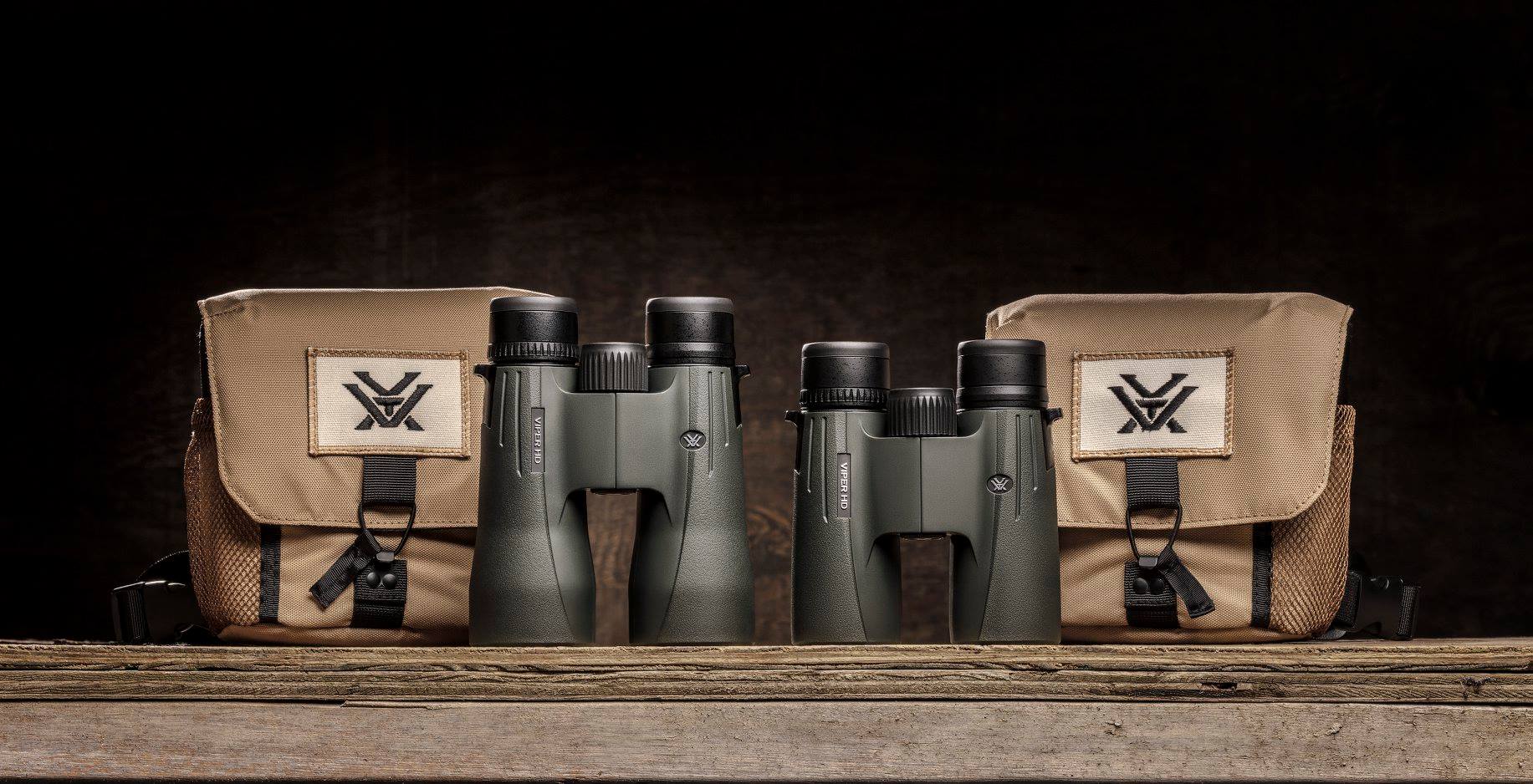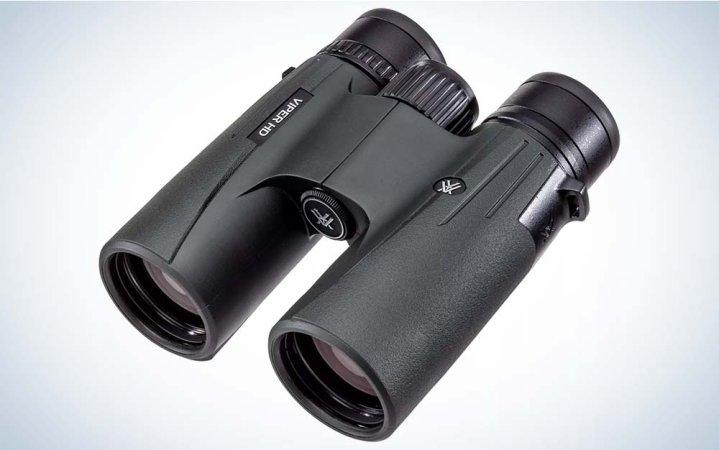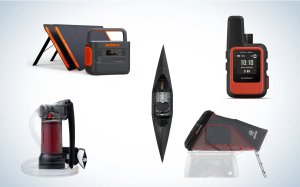We may earn revenue from the products available on this page and participate in affiliate programs. Learn More ›
The Vortex Viper HD binoculars are the rare Goldilocks binoculars. They’re neither too small, as some highly portable compacts can be, nor too big as some of the mega-chassis 15-power binoculars are. Instead, these occupy a very happy, just-right spot in between not only sizes and optical performance, but also pricing.
Meet Vortex’s Viper HD. We’re going to talk mainly about the 8×42 model, but I’ve been hunting with its big brother, the Vortex Viper HD 10×42, for years and because the only real difference is magnification, all the perspectives of size and performance of the 8X apply equally to the 10X. Note that the Viper HD line also has 10×50 and 12×50 models.
The Vortex Viper HD represents a region of the binocular market that’s relatively underserved by manufacturers. They have given us plenty of entry-level optics, made with forgettable glass inside polycarbonate bodies that adequate optical performance but an appealing price, generally inside $250. Then we have the heirloom-class binoculars, often made by European brands, that cost 10 times that amount, but have spectacular glass surrounded by lovely bones.
But the Viper HD, along with only a half-dozen peers, gives you excellent optics for well under $1,000. In fact, you can probably find this binocular for about half that price.
Vortex Viper HD Specs
- 8-power roof prism with 42mm objective lenses
- 3-position eyecups
- Weight: 24.5 ounces
- Field of View: 409 feet at 1,000 yards
- Eye Relief: 18 mm
- Close Focus: 5 feet
- Chassis Material: Polycarbonate
- Warranty: Fully transferrable lifetime
- $839 MSRP
Vortex Viper HD Overview
Unlike many Asia-sourced binoculars, the Vortex Viper HD uses a higher class of glass. While Vortex calls this “HD,” which stands for high-definition, there is no real quantitative measure of this category. Unlike fluorite or “ED” glass, which stands for extra-low-dispersion, brands can use “HD” pretty much at will. However, my testing indicates that Vortex’s blend of glass provides better light transmission, low-light performance, and color renditions than that in its Vanquish and Raptor lines, which use standard glass.
You can test the optics yourself. It’s easiest when you have a second binocular to compare the image with, but even if you don’t, stabilize a Viper HD against a fencepost or car door or other solid rest, and pay close attention to the outside of the image. You shouldn’t see any distortion, or blurring, with the Viper HD. You often do with binoculars made with inferior glass.
You may also notice the light weight of the Vortex Viper HD. That’s a function of the polycarbonate chassis. As you move up in price, you’ll often start to see composition of binoculars change from polycarb to aluminum to magnesium, and then other, more exotic alloys. The stiffer the chassis, the more durable the binocular. But the polycarbonate body gives two advantages to the Vortex binoculars. First, it’s lighter than a metallic body. Second, the polycarbonate tends to dampen vibrations, so you should see less shaking of the image inside the Viper HD.

What the Vortex Viper HD Does Best
Given its all-around talents, the Vortex Viper HD is at its portable best in the field, whether hunting or birdwatching, hiking, or traveling. The relatively short barrel—it’s only 5-1/2 inches from objective lens to eyecup—makes it easy to deploy from a chest harness, and at less than 1-1/2 pounds, it doesn’t weigh down your neck.
It’s also very comfortable in-hand, thanks to that light weight and short stature. But Vortex has sculpted detents on the underside of each barrel, which easily find the swell of your thumbs and enable users to lock in the optic to minimize shaking. The 3-position eyecups are positive and comfortable, and the textured finish is easy to grab and hold without feeling slick. All that adds up to one of the best compact binoculars for the money.
Testing the Vortex Binoculars
I put the Vortex Viper HD into service for two successive deer seasons in my home in Montana, and have been happy with their performance. Deer season covers the gamut from hot and windy to cold and snowy, and the binocular handled all the temperature and atmospheric conditions without a hitch.
I opt for the 10×42 version for most of my open-country deer hunting, but for treestand hunting, I wear the 8×42. They give me significantly more field of view and a few more minutes of low-light brightness, capabilities I’d gladly trade for a little less magnification.
One of the attributes of the Vortex Viper HD, that’s both a nice touch and overlooked by many users, is its locking diopter. The diopter adjustment is the knurled ring on the right barrel of most binoculars. It’s used to focus the eyepiece for each user’s optical prescription, and most simply turn without locking. Vortex’s version requires users to lift the ring slightly until they hear a click, then turn the diopter to their particular focus, and then push it back in the locked position when finished. That ensures that it won’t turn inadvertently, an important consideration when you’re using a binocular harness.
I also like the threaded tripod adapter on the front side of the center hinge. That accepts a threaded tripod mount in order to fully stabilize this optic, an important consideration for long glassing sessions.
What the Vortex Viper Does Worst
While I’ve talked about the benefits of its polycarbonate body — reducing weight and dampening vibration — I’d really like to see the Viper HD with a magnesium or aluminum-alloy chassis. It makes optics more rigid and durable, and because there’s no movement, it provides solid, more rigid mounting surfaces for the lenses. Overall, it makes for a better-quality optic.
I haven’t seen evidence that the polycarb body of the Viper HD diminishes optical performance, but all things being equal, I think Vortex could justify bringing out a metallic body at this price point.
In terms of field utility, the only ding I’d give the Vortex HD is its spongy focus wheel. The wheel turns with positivity and just the right amount of resistance, but it feels just a little mushy in hand, and strays often enough that I have to frequently tack up the dial to keep the image in focus.

How the Vortex Binoculars Stacks Up Against its Peers
It’s this category where the Vortex Viper HD shines. I’d consider its peer group to consist of models like Leupold’s BX-4 Pro Guide, Athlon’s Cronus G2, the B.1 from Maven, and GPO’s Passion HD line. It also half the price of the Vortex Razor HD, and for many hunters the Vipers might be the better buy.
In general, the Vortex Viper HD compares very well against that class. They all have excellent glass for the price, they each has very good durability and ergonomics, and what I’d generally call field-worthiness. The Vortex has the additional benefits of being a bit lighter in weight, and its overall comfort index—as measured by the thumb detents on the barrels, the tasty eyecups, the large ocular lenses, and the balance—is in line with the best of its peers.
In addition, the Viper HD is covered by Vortex’s legendary VIP Warranty, which is fully transferrable for the lifetime of the optic. If it breaks, or something goes wrong with the glass or chassis, Vortex will either fix or replace it for free. That’s a great benefit that many other optics brands have adopted for their own products.
Add the fact that Vortex ships with an excellent Glasspak harness (a $50 value) makes the value proposition of the Viper HD even better. One additional note about price. Vortex shows the retail price at $839, but you should be able to find the Viper HD on sale for closer to $500.
Does the Vortex Viper HD Accomplish its Mission?
The Vortex Viper binoculars don’t pretend to be a high-end optic costing several thousand dollars. It doesn’t even pretend even to be the best Vortex. Instead, it has found a very successful niche in the middle, not only of the price and performance spectrum, but also in the middle of Vortex’s binocular lines. Given its mission to deliver good optical performance in a very portable and reasonably durable package, the Vortex Viper HD is a good choice for a wide variety of hunting scenarios. If you intend to do a lot of long-distance glassing, you might consider stepping up to the 12×50 size. If you are a bowhunter or hunt primarily in Eastern woodlands, the 8×42 should be a great fit. And if you’re a Western walk-about hunter, either the 10×42 or the 10×50 are good choices.
For me, either the 8×42 or 10×42 have been great all-around hunting binoculars. I keep the Vortex Viper HD in my pickup so I always have a quality binocular at my disposal, whether I’m taking a hike or simply glassing from a parking spot. It says a lot about the Viper HD that, of all the binoculars in my collection, this is the one that gets to ride shotgun.



